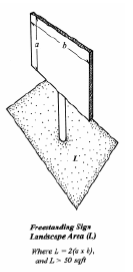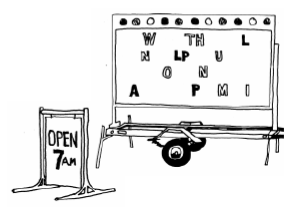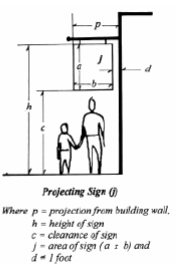Unless otherwise provided elsewhere in these regulations, the following signs shall be permitted in the village as accessory structures, subject to the following and all other applicable standards:
(A) Awning signs. Where permitted in § 159.126(A), Sign Classification Table, awning signs shall be permitted subject to the following:
(1) Number. Not more than one awning sign shall be permitted on each awning.
(2) Location. Individual letters, words or symbols may be affixed or applied to any awning surface facing a public street or mounted over a public entrance to an establishment and shall not face a residential lot.
(3) Height. The maximum height of an awning sign shall be the highest point of the awning to which the sign is attached or 16 feet, whichever is less.
(4) Sign display area limits. The awning sign shall not extend beyond the awning surface on which the sign is located, nor beyond the premises of a particular establishment.
(5) Sign area. The area of an awning sign shall not exceed one and one-half square feet of sign area for each lineal foot of awning, and the actual signage face shall not exceed three feet in height.
(6) Illumination. Awning signs may be illuminated subject to the standards in § 159.124.
(7) Clearance. A minimum clearance of eight feet shall be provided between finished grade and the lowest point of an awning sign, but in no instance shall an awning sign extend below the lowest point of the awning to which the sign is attached.
(8) Projection. No awning sign and the awning to which it is affixed shall project more than eight feet from the building wall, but shall not project into or over the roadway of any street or driveway.
(9) Setback from curb. No awning sign and the awning to which it is affixed shall project within two feet of the curb of a street or driveway or parking space.
(B) Canopy signs. Where permitted in § 159.126(A), Sign Classification Table, canopy signs shall be permitted subject to the following:
(1) Number. Not more than one canopy sign shall be permitted per street frontage per building or tenant space having an exterior public entrance.
(2) Location. Canopy signs shall be mounted on the face of a canopy.
(3) Height. The maximum height of a canopy sign shall be the highest point of the canopy to which said sign is attached or 18 feet, whichever is less.
(4) Sign display area limits. The canopy sign shall not extend beyond the canopy face on which the sign is located, nor beyond the premises of a particular establishment.
(5) Sign area. The area of a canopy sign shall not exceed one and one-half square feet of sign area for each lineal foot of awning, and the actual signage face shall not exceed three feet in height.
(6) Illumination. Canopy signs may be illuminated subject to the standards in § 159.124.
(7) Clearance. A minimum clearance of eight feet shall be provided between finished grade to the lowest point of a canopy sign, but in no instance shall a canopy sign extend below the lowest point of the canopy on which the sign is attached.
(8) Projection. No canopy sign shall project more than 12 inches from the canopy to which it is attached.
(C) Freestanding signs. Where permitted in § 159.126(A), Sign Classification Table, freestanding business, identification and development signs shall be permitted subject to the following:
(1) Development signs.
(a) Number. Each multiple tenant development having a minimum of 25 acres of area shall be permitted one freestanding development sign for each 25 acres of land area, but in no case shall more than two such signs be permitted on a development parcel and provided there is only one such sign per street frontage.
(b) Location. No development sign shall be located closer than ten feet from any property line, and shall be located not less than 25 feet from any residential zoned lot. No development sign shall be located closer than 100 feet to another permanent freestanding sign.
(c) Height. No development sign shall exceed 25 feet in height.
(d) Sign area. The maximum sign area shall be 150 square feet.
(e) Illumination. Development signs may be illuminated subject to the standards in § 159.124.
(f) Time and temperature displays. Time and temperature displays may be incorporated into a development sign provided location, area and other technical requirements herein are satisfied. The area of any time and temperature displays shall be included in the maximum sign area.
(g) Message board sign. Message board/dynamic display signs shall be permitted when incorporated into a development sign subject to all applicable standards set forth § 159.129(L).
(h) Distance from buildings. No development sign shall be located closer than ten feet to a building.
(i) Sign landscaping. All development signs shall be located in a landscaped area separated and protected from vehicular circulation and parking areas. A minimum of two square feet of landscaping area shall be required for every one square foot of sign surface area provided, but no development sign landscape area shall be less than 50 square feet in area. Said landscape area shall be landscaped appropriately.

(j) Architectural feature. All development signs shall be designed and constructed as an integral architectural element of the overall development incorporating elements and details and building materials used in the principal building(s). The area and height of the architectural feature shall not be computed as part of the development sign area and height.
(k) Multi-tenant signs. Any sign constructed with tenant panels must not have blank tenant panels at any time.
(2) Business and identification signs.
(a) Number. Each lot or development having less than 25 acres of area shall be permitted one freestanding business or identification sign for each street frontage.
(b) Location. No freestanding business or identification sign shall be located closer than ten feet from any property line, and shall be located not less than 25 feet from any residential zoned lot. No freestanding business or identification sign shall be located closer than 100 feet to another permanent freestanding sign.
(c) Height. No freestanding business or identification sign shall exceed ten feet in height.
(d) Sign area. The maximum sign area shall be 25 square feet.
(e) Illumination. Freestanding business or identification signs may be illuminated subject to the standards in § 159.124.
(f) Time and temperature displays. Time and temperature displays may be incorporated into a freestanding business or identification sign provided location, area and other technical requirements herein are satisfied. The area of any time and temperature displays shall be included in the maximum sign area.
(g) Message board sign. Message board/dynamic display signs shall be permitted when incorporated into a business identification sign subject to all applicable standards set forth in § 159.129(L).
(h) Distance from buildings. No freestanding business or identification sign shall be located closer than ten feet from a building.
(i) Sign landscaping. All freestanding business or identification signs shall be located in a landscaped area separated and protected from vehicular circulation and parking areas. A minimum of two square feet of landscaping area shall be required for every one square foot of sign surface area provided, but no development sign landscape area shall be less than 50 square feet in area. Said landscape area shall be landscaped appropriately.
(j) Decorative sign base. All freestanding business or identification signs shall be designed and constructed with an integral decorative base constructed of wood, metal, masonry, or stone to conceal the sign’s support structure(s) and to visually compliment the building materials used on the principal building(s) on the lot. The decorative base shall be equal to at least 75% of the width of the sign face. The area of the decorative sign base shall not be computed as part of the sign area. The height of the decorative sign base shall be computed in determining the sign height.
(k) Multi-tenant signs. Any sign constructed with tenant panels must not have blank tenant panels at any time.
(D) Portable signs. Where permitted in § 159.126(A), Sign Classification Table, portable signs shall be permitted subject to the following:
(1) Number. No more than one portable sign shall be permitted on a lot at any one time. Such sign that must be transported by motor vehicle and/or on a trailer may only be used as a grand opening sign.
(2) Location. Portable signs shall comply with all location requirements for free-standin g signs, with the exception that portable signs may be located closer than 100 feet from a freestanding sign.

(3) Sign area. The area of a portable sign shall not exceed 32 square feet.
(4) Duration of display:
(a) No portable sign shall be displayed for more than 30 consecutive days within six months of occupancy of a building or tenant space.
(b) Portable signs may be displayed only for grand-opening or grand re-opening celebrations.
(E) Projecting signs. Where permitted in § 159.126(A), Sign Classificati on Table, projecting identificati on signs shall be permitted subject to the following:

(1) Number. Not more than one projecting sign per establishment shall be permitted on a building wall facing a public street and/or having a public entrance, provided no canopy sign for the establishment are located on the same building wall.
(2) Location. Projecting signs shall be affixed to the wall having the establishment’s public entrance and shall not be located beyond the premises of a particular establishment.
(3) Height. No projecting sign shall extend above the roof line or the highest point of the wall of the building on which it is located or 14 feet from finished grade, whichever is less.
(4) Sign area. The area of a projecting sign shall not exceed 16 square feet.
(5) Illumination. Projecting signs may be illuminated subject to the standards in § 159.124.
(6) Clearance. Projecting signs shall provide a minimum clearance of eight feet between the finished grade below the sign to the lowest edge of the sign.
(7) Projection. No projecting sign shall project from the building wall more than six feet. The innermost edge of the projecting sign shall be no more than one foot from the wall of the building to which it is attached. Projecting signs may swing, but all projecting signs shall be permanently attached to the building.
(8) Setback from curb. No projecting sign shall project within two feet of the curb of a street or driveway or parking space.
(F) Reserved.
(G) Temporary signs. Where permitted in § 159.126(A), Sign Classification Table, temporary signs shall be permitted subject to the following:
(1) Location. Temporary signs shall comply with all location requirements for freestanding, wall, and window.
(2) Number. No more than one- third of the businesses on any individual lot may display temporary signs concurrently.
(3) Height. Temporary signs shall comply with the height requirements for freestanding, wall, and window.
(4) Sign area. No freestanding temporary sign shall exceed 32 square feet in area and eight feet in height. No temporary sign attached to an awning, canopy, or wall shall exceed 60 square feet in area.
(5) Illumination. Temporary signs shall not be illuminated.
(6) Duration of display:
(a) Temporary signs shall be permitted for no more than 30 consecutive days.
(b) Temporary signs shall not be displayed more than one time in any one calendar year by an establishment on a lot.
(H) Wall signs. Where permitted in § 159.126(A), Sign Classification Table, wall signs shall be permitted subject to the following:
(1) Number. Not more than one business and identification wall sign per street frontage or per building wall having a public entrance per establishment shall be permitted, provided no canopy sign for the same establishment is directed to the same street frontage, except that:
(a) Not more than one business or identification wall sign may be permitted on walls not facing a street or having a public entrance, provided the wall does not face a residential lot and is at least 50 feet from the nearest property line or another building on the lot.
(b) No wall signs shall be allowed for individual tenants in a multi-story or a multi-tenant building having no exterior building entrance for each tenant.
(2) Location. Wall signs shall be affixed only to a wall having the establishment’s public entrance or a wall facing a public street.
(3) Height. The maximum height of a wall sign shall be 30 feet from finished grade adjacent the wall to which the sign is attached.
(4) Sign display area limits. The wall sign display area shall not extend above the wall of a building, beyond the premises of a particular establishment in a building, or over clear breaks in architectural façade on the wall face.
(5) Sign area. The total area of all wall signs per wall shall not exceed one and one-half square feet per lineal foot of wall to which the sign is attached.
(a) For individual tenant spaces under 30,000 square feet, the actual signage face shall not exceed three feet in height.
(b) For individual tenant spaces in the P-B, M-1, or M-2 District 30,000 square feet or greater, wall signs may not exceed five feet in height. The sign must also be framed by at least two feet of clear wall space preceding and following any text or image.
(6) Illumination. Wall signs may be illuminated subject to the standards in § 159.124.
(I) Window signs, illuminated. Where permitted in § 159.126(A), Sign Classification Table, illuminated business and identification signs may be placed or positioned within three feet of the interior of window glass subject to the following:
(1) Location. Window signs may be displayed only in windows facing a public street, or in windows in a wall having a public entrance, but in no instance in any windows facing a residential lot.
(2) Sign display area. Each illuminated window sign shall be located within the exterior glass surface area of all permitted windows, but excluding doors and superficial borders or trim.
(3) Sign area. All window signs shall occupy no more than 50% of the total window surface area of a storefront facing the public street.
(4) Illumination. Window signs may be illuminated subject to the standards in § 159.124.
(5) Number. No more than two illuminated window sign shall be permitted for each tenant space.
(Ord. 15-1190, passed 9-16-15; Am. Ord. 22-1794, passed 9-21-22)